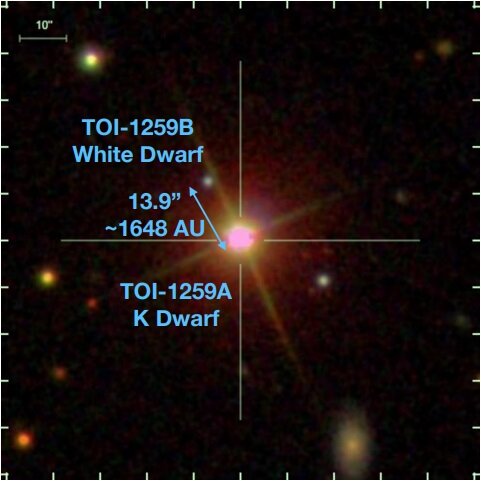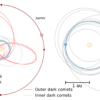Using NASA’s Transiting Exoplanet Survey Satellite (TESS), an international team of astronomers has discovered an interesting extrasolar planetary system consisting of a K-dwarf host star, a Jupiter-sized planet and a white dwarf. The finding and parameters of the system, designated TOI-1259, were presented in a paper published January 7 on the arXiv pre-print repository.
TESS is conducting a survey of about 200,000 of the brightest stars near the sun with the aim of searching for transiting exoplanets. So far, it has identified over 2,450 candidate exoplanets (TESS Objects of Interest, or TOI), of which 91 have been confirmed so far.
Now, a group of astronomers led by David V. Martin of the Ohio State University in Columbus, Ohio, reports the detection of a transit signal in the TESS light curve of the TOI-1259A star—a K-dwarf star located some 385 light years away. The planetary nature of this signal was confirmed by follow-up observations using ground-based telescopes.
According to the paper, the parent star TOI-1259A has a radius of about 0.71 solar radii and is some 25% less massive than our sun. It has a metallicity at a level of about -0.5 and effective temperature of around 4,775 K.
The exoplanet, designated TOI-1259Ab, is the size of Jupiter but approximately 56% less massive than the solar system’s biggest planet. The alien world orbits its host every 3.48 days, at a distance of about 0.04 AU from it. The planet’s equilibrium temperature was estimated to be approximately 963 K.
What makes TOI-1259 a peculiar planetary system is the presence of a bound white dwarf companion (TOI-1259B). The object is separated by 1,648 AU from the host star and has an effective temperature of about 6,300 K. The researchers found that TOI-1259B has a radius of 0.013 solar radii and a mass of approximately 0.56 solar masses.
The properties of the white dwarf allowed the team to derive a total age of the system. They estimate that TOI-1259 is around 4.08 billion years old.
Summing up the results, the researchers noted that the white dwarf is presently at a separation not predicted to impact planet formation. However, they discuss the possible influence of this object on the formation and evolution of TOI-1259Ab in the past.
“During its main sequence lifetime, the white dwarf’s progenitor would have been both more massive (∼1.59 solar masses) and much closer (∼900 AU, assuming adiabatic mass loss). At this point, secular effects such as Kozai-Lidov may have been relevant to the planet. Indeed, the Kozai-Lidov effect may have brought the planet to its current orbital configuration, by inducing high-eccentricity tidal migration, if the planet started out at a wider orbit, as would be expected for a gas giant,” the astronomers concluded.
Two young planetary systems detected by TESS
More information:
TOI-1259Ab – a gas giant planet with 2.7% deep transits and a bound white dwarf companion, arXiv:2101.02707 [astro-ph.EP] arxiv.org/abs/2101.02707
2021 Science X Network
Citation:
Astronomers find planetary system with gas giant exoplanet and white dwarf companion (2021, January 18)
retrieved 18 January 2021
from https://phys.org/news/2021-01-astronomers-planetary-gas-giant-exoplanet.html
This document is subject to copyright. Apart from any fair dealing for the purpose of private study or research, no
part may be reproduced without the written permission. The content is provided for information purposes only.



